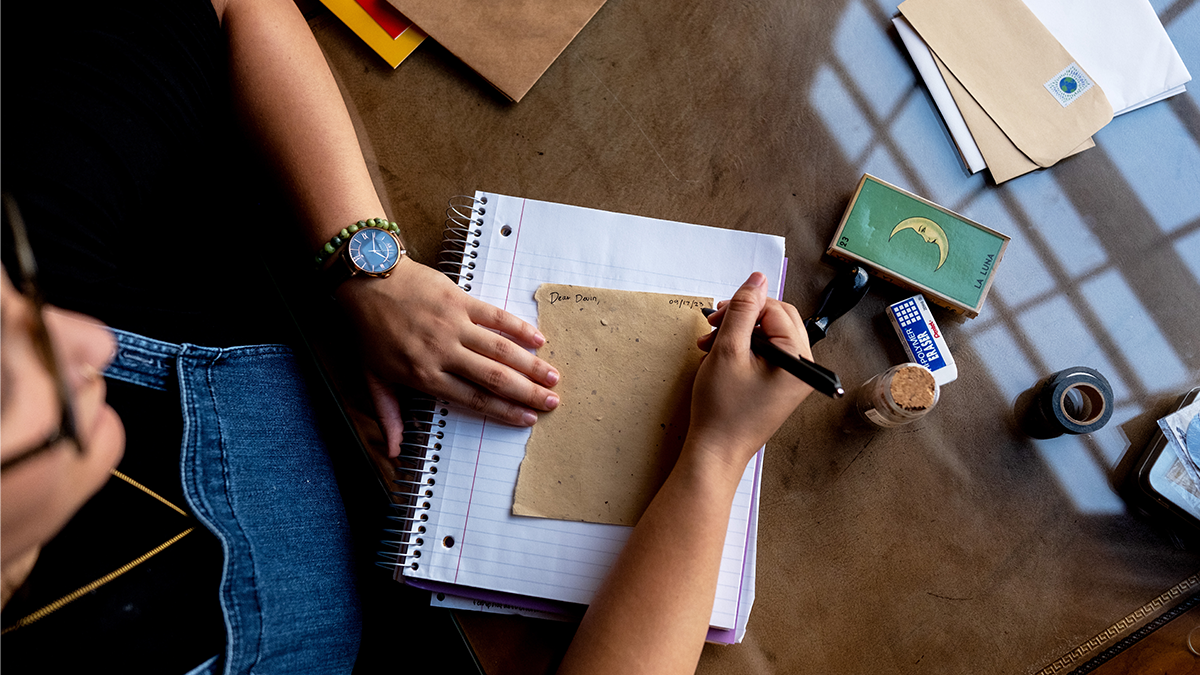Why handwritten letters mean so much
A student’s lifelong appreciation for writing and receiving letters exemplifies faculty expert Sara Algoe’s research on emotions.

In this era of instant communication, Siena Rodrigues is a rarity — a busy college student who hand-writes letters.
She began writing letters before starting preschool and hasn’t stopped. Since then, she’s written hundreds of letters to friends and family. The psychology and neuroscience major who works in Professor Flavio Frohlich’s lab in the School of Medicine’s psychiatry department also encourages others to write to her.
As a young child attending church with her mother, Rodrigues stayed occupied with a box of trinkets and stationery. “I don’t’ remember this, but I apparently wrote letters to parishioners and left them by the Mary statue,” she said.
Letters allowed Rodrigues to “tell someone anything you wanted to” and express her feelings in ways that transcended time. “Maybe I can’t tell you I love you in this minute, but in a letter, it doesn’t matter,” she said.
Rodrigues, a junior Morehead-Cain Scholar from Signal Mountain, Tennessee, knows why people relish letters. “Sitting down with a piece of paper and pen, you come with an intention of ‘I’m not only going to think these thoughts or tell you these thoughts, but I’m going to write them down.’ The power of that physical act makes it more personal rather than a thought,” Rodrigues said.
Sara Algoe, a professor in the psychology and neuroscience department in the College of Arts and Sciences, who researches social interactions, agrees. “A letter shows this person was thinking about me and took the time to actually put pen to paper,” Algoe said. “As humans, we want to feel valued and loved and respected, and a letter signals that.

(Jon Gardiner/UNC-Chapel Hill)
“Letters also usually disclose a person’s thoughts and feelings at some level, like ‘I was excited to see you last month,’ or ‘This is how I’m thinking about a situation,’” Algoe said.
Research in psychology and relationship science by Algoe and others supports the idea that self-disclosure creates closeness and intimacy. Those feelings may then cause a letter recipient to contact the sender or take steps to see them sooner than planned.
“Those are the ways that relationships get built over time, by one person doing something that literally draws the other person in,” Algoe said.
That’s what happened when Rodrigues’s now-boyfriend, who lived nearby in Signal Mountain, came to her house on Thanksgiving four years ago. He couldn’t stay long, and while leaving, handed Rodrigues a letter. “I don’t think he knew how much I loved letters,” she said. In the letter, he told her that he loved her for the first time. “I immediately wrote a letter to him, and after dinner, I walked the 10 minutes to his house to give it to him.”
Rodrigues primarily uses notebook paper, sometimes handmade paper for special occasions, and short, brown envelopes that fold over. Her friends call them “Siena letters.”
Letters are timeless, Rodrigues said, especially for stories and momentous events. “Holding that documentation of exactly when somebody told you they love you is amazing. We may remember the conversation, but there’s nothing like having a definitive piece of paper to capture that moment and your feelings,” she said.
Rodrigues’s letter-writing tips include:
•Don’t force the process. “If I’m walking or not focusing on something, I start getting ideas. By the time I sit down and write, I usually have a good idea of what I will say.”
•Let daily gratitude inspire you. “I think about why I’m grateful for a person or what in our interactions is meaningful.”
•Listen to music. Her go-to song is “Naked as We Came” by Iron and Wine. “It has this repetitive melody and it’s calm.”







